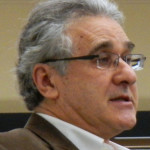Opinion: Scientists working to protect Lake Tahoe
By Geoff Schladow
Another year has come and gone at Lake Tahoe, and it was no ordinary year. We had one of the most extreme winters of snow on record. Lake levels came up 7 feet in a few months and thin ribbons of sand replaced the wide beaches of the last few years. Long forgotten seasonal springs re-emerged on hillsides and wildflowers seemed to last all summer.
Other things about the lake were different too. While the annual record is still being collected and analyzed, early indications are that we are experiencing conditions not seen before, be it high lake temperature or different floating algae. What is science doing to understand and control the changes in the lake and in the forests?

Geoff Schladow
Two new projects in 2018 are aimed precisely at addressing these changes. A pilot project in Emerald Bay is looking at restoring Lake Tahoe’s native food web by locating and removing the invasive Mysis shrimp using new, sophisticated echo sounding equipment. Earlier research has shown that Mysis removal can lead to a return of native zooplankton, a restoration of clarity, and improved fish health in one year. But the changes at Tahoe are not just restricted to the lake. A new project to restore sugar pine trees in areas of the North Shore that have suffered high tree mortality due to prolonged drought and associated pine beetle activity is also commencing in 2018.
These projects that go to the heart of restoring Lake Tahoe have been made possible through a combination of funding. This includes funds from the California Tahoe Conservancy, Nevada Division of Environmental Protection, Tahoe Fund, UC Davis, and individual community members. This broad base of support is essential, and makes it possible to attract the best scientists and students and to apply the newest technological approaches. Even though Tahoe has been studied for half a century, the challenges we are experiencing are evolving and the science needs to evolve even faster.
While we hope these two projects will achieve their goals, hope is not a strategy. To that end, we continue to work on the essential task of understanding, at a fundamental level, how the Lake Tahoe Basin is changing. From underwater robotic vehicles that silently track the motions of the water, to measurements on the exchanges of carbon that occur in the forests, to high school programs that train and spark the imagination of future scientists, we are embarking on the science that will be needed to save the lake.
To all who have contributed to our achievements this year, my heartfelt thanks. This includes our dedicated staff, our amazing volunteer docents, the students and interns that work at TERC, our partners in other research institutes and our colleagues in the various Tahoe agencies, those who visit our education centers, and those of you who have supported our research and education programs and partnered with us in unique ways.
My very best wishes for a safe and peaceful holiday season. I look forward to working together again in 2018.
Geoff Schladow is director of UC Davis Tahoe Environmental Research Center. This column was first published in the TERC newsletter.


